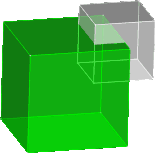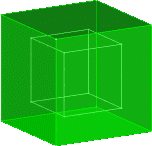Penetration Panel |

|

|

|

|
|
Penetration Panel |

|

|

|

|
User Profiles: |
Incremental_RADIOSS Incremental_LS-DYNA RADIOSS One Step Die Module |
The Penetration panel can be accessed by clicking Mesh > Check > Components > Penetration.
Penetration is defined as the overlap of the material thickness of shell elements, while Intersection is defined as elements that actually pass completely through one another:

These diagrams illustrate the concepts of penetration and intersection.
Penetration checking is supported by all of the impact solver interfaces such as LS-DYNA, RADIOSS and PAMCRASH, and works best with a user profile that supports thickness data for modeled shell elements. Note that the default HyperMesh user profile does not support modeled element thickness, but the penetration checking tools let you to specify a uniform thickness when performing a check.
| • | The Penetration panel lets you set up and initiate a check only; the main checking tool options become available in the tab area after running an initial check. |
| • | When the penetration check runs, it automatically masks (hides) everything in your model except for the penetrating or intersecting elements. It then fits the view to these elements’ components. You can show or hide additional elements using toolbar buttons located in the Penetration tab, and you can make other entity types (such as ellipsoids) visible again via the Display panel or the Mask panel. |
| • | Solid entities never register penetrations between each other; instead, any overlap between solids registers as intersections, because one or more of each the solid’s faces intersect. A solid that is completely contained within another solid will not be detected as an intersection or penetration, because its faces will not intersect any of the larger (containing) solid’s faces. In addition, only surface elements register penetrations; the tool cannot find penetrations between internal (e.g. tetra- or hexa-) elements. |


Intersection would be found in the left image, but not in the right.
| • | Solids can register penetrations with respect to adjacent shell elements, based on the thickness of the shell elements. |
An Alphabetical List of Panels